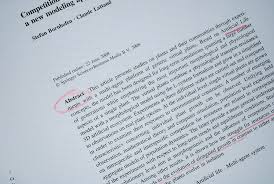
|
Getting your Trinity Audio player ready...
|
The role of an abstract in attracting readers and reviewers
In a previous blog post, we explained how an abstract is arguably the most important section of your peer-reviewed article. Why? Because in today’s busy world, people have limited time and energy, and an abstract allows them to understand the essence of a peer-reviewed paper as quickly as possible. Of course, some readers will review the entire article in detail, but even in those cases it is likely that they, too, will start with the abstract and use it to decide whether to continue reading or not.
In other words, the abstract is the first encounter a potential reader has with your research. It often determines whether someone chooses to read the rest of your paper or move on. Put simply, an engaging abstract can make all the difference. It must capture the essence of your study succinctly and compellingly, enticing readers with the promise of valuable insights.
From the publishing side, an effective abstract is instrumental in facilitating the peer review process. Reviewers often use it to gauge the relevance and quality of your research before diving into the full manuscript. A well-crafted abstract sets the tone for the entire paper and can create a positive predisposition in the reviewer’s mind, potentially impacting their overall perception of your work.
Key elements of a powerful abstract
Here are the key elements that you should incorporate :
1. Clarity and Conciseness. Exceptional abstracts have one thing in comment: clarity. The text quickly and efficiently conveys the essence of your study. Avoid technical jargon and complex language. Instead, use clear, concise sentences to make your research accessible to a broader audience. A well-written abstract distills your study’s core elements without sacrificing nuances.
2. Objective and Scope. Begin by clearly stating the objective of your research. What question were you aiming to answer or what problem were you trying to solve? This places your research in the context of the larger field of research in which you’re working, and it sets the stage for the reader to understand the significance of your study. Briefly outline the scope of your research to give readers a sense of what to expect in the full paper.
3. Methodology. A brief overview of your research methodology provides insights into the rigor and approach of your study. Resist the temptation here to get too detailed—save that for the body of the paper itself. It’s enough to simply identify the techniques by name without describing each step involved.
4. Key Findings. This is the heart of your abstract. Highlight the most significant results of your research. Be specific and quantitative where possible, as concrete data attracts greater attention and credibility. However, avoid overloading this section with too many details, as the goal is to pique interest, not to provide an exhaustive summary.
5. Implications. Every strong abstract concludes with a statement on the implications of the findings. What new understanding does your research contribute to the field? How does it advance the conversation or challenge existing paradigms? This element showcases the value and impact of your work, encouraging readers to delve into the full manuscript.
Avoid common mistakes in abstract writing
In most cases, you will be constrained in the format of your abstract as journals often have a required outline or format that you must follow. Regardless of these requirements, when mastering the art of abstract writing it’s important to be aware of common pitfalls that can diminish the impact of your work. Avoid these common mistakes:
1. Overgeneralization. A common error is making the abstract too vague or broad. Your abstract not only summarizes the study, but is should also explain its unique contribution to the field. In other words, focus on what sets your research apart.
2. Excessive Details. Conversely, including too much detail can overwhelm the reader (and, even more likely, push you past the publisher’s acceptable word count!). Remember, an abstract is not a miniature version of your paper but a concise snapshot. Just highlight key findings and insights and leave detailed explanations and data for the main text.
3. Neglecting Keywords. You may not have thought of it, but even for academic articles, in the digital age, overlooking search engine optimization (SEO) is a significant oversight. Failing to include relevant keywords can render your paper invisible in online searches, significantly reducing its reach. Choose keywords carefully and ensure that they are both integral to your research and commonly used in your field.
4. Lack of Focus on Results and Implications. Some abstracts focus too much on background or methodology, often at the expense of results and implications. Yes, context is important, but remember that readers are primarily interested in what you discovered and why it matters.
5. Inconsistent Narrative. Incredibly, some authors end up writing abstracts that don’t really relate to the paper itself! Your abstract should align with the content of your full paper. Inconsistent data, assertions, or conclusions between your abstract and the main manuscript will just confuse readers and undermine your credibility.
By avoiding these common mistakes, you can enhance the effectiveness of your abstract, ensuring it serves as a compelling ambassador for your research. Next, we will examine examples of effective abstracts across different fields to provide concrete illustrations of these principles in practice.
Editage also provides editorial services here









Leave a Reply